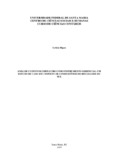| dc.contributor.advisor | Rossato, Marivane Vestena | |
| dc.creator | Rigon, Letícia | |
| dc.date.accessioned | 2019-09-18T16:38:28Z | |
| dc.date.available | 2019-09-18T16:38:28Z | |
| dc.date.issued | 2019-07-04 | |
| dc.date.submitted | 2019-07 | |
| dc.identifier.uri | http://repositorio.ufsm.br/handle/1/18268 | |
| dc.description.abstract | Accounting as a provider of useful information for the analysis of the economic and patrimonial situation of the companies, has much to contribute to the small and medium ones, in which the management takes place in empirical way, with knowledge in past practical experiences. This study was developed together with a small gas station, whose management required economic and financial information. In order to do this, we used Cost / Volume / Profit Analysis and tried to answer the following problem question: what is the marketing mix capable of meeting total costs and expenses? The purpose of this study was to determine the average monthly sales mix, firstly by identifying the revenues (in units and value) and the company's expenses, subsequently calculating the unit and total contribution margin of the main products of the station, with these variables ( fixed costs, contribution margin and sales volume) determine the financial equilibrium (PE). Afterwards, each product was allocated its share in the financial PE, that is, the marketing mix in the EP. In order to contribute with more information, the Management Result Statement and the security margin of the position were also prepared. In its methodological aspects the research is characterized as being of a qualitative nature, and for the fulfillment of its objectives, this consists of a descriptive research. Based on the adopted procedures, it is a case study with the use of semistructured interviewing techniques and documentary research. Among the main results, it should be noted that the average monthly financial PE, in units, corresponds to 50,542.43 and in amount R $ 221,197.99. The study also found that the Common Gasoline product is the one with the largest share in the Break-even point. It was concluded that the Cost / Volume / Profit Analysis has applicability to small business and generates numerous benefits the same. He revealed to the manager of the Fuel Station studied various information that he did not know how, which products have the highest Total Contribution Margin, the sales volume in which revenues are equal to the expenses, which is the managerial operating result. | eng |
| dc.language | por | por |
| dc.rights | Acesso Aberto | por |
| dc.subject | Posto de combustíveis | por |
| dc.subject | Fuel station | eng |
| dc.subject | Mix de comercialização | por |
| dc.subject | Análise custo/volume/lucro | por |
| dc.subject | Mix marketing | eng |
| dc.subject | Cost/volume/profit analysis | eng |
| dc.title | Análise custo/volume/lucro como instrumento gerencial: um estudo de caso em um posto de combustíveis do Rio Grande do Sul | por |
| dc.title.alternative | Analysis of cost/volume/profit as a management instrument: a case study at a fuel post of Rio Grande do Sul | eng |
| dc.type | Trabalho de Conclusão de Curso de Graduação | por |
| dc.degree.local | Santa Maria, RS, Brasil | por |
| dc.degree.graduation | Ciências Contábeis | por |
| dc.description.resumo | A contabilidade como provedora de informações úteis para a análise da situação econômica e patrimonial das empresas, muito tem a contribuir para as pequenas e médias, nas quais o gerenciamento se dá de maneira empírica, com conhecimento em experiências práticas passadas. Este estudo foi desenvolvido junto a um posto de combustíveis, considerado de pequeno porte, cujo gerenciamento necessitava de informações de caráter econômico e financeiro. Para tal, fez-se uso da Análise Custo/Volume/Lucro e buscou-se responder a seguinte questão-problema: qual é o mix de comercialização capaz de fazer frente aos custos e despesas totais? Nesse intuito, objetivou-se determinar o mix de comercialização médio mensal, primeiramente identificando as receitas (em unidades e em valor) e gastos da empresa, posteriormente apurando a margem de contribuição unitária e total dos principais produtos do posto, para com essas variáveis (gastos fixos, margem de contribuição e volume de vendas) determinar o ponto de equilíbrio (PE) financeiro. Após, atribuiu-se a cada produto a sua participação no PE financeiro, ou seja, o mix de comercialização no PE. A fim de contribuir com mais informações, elaborou-se também a Demonstração de Resultado Gerencial e a Margem de segurança do posto. Em seus aspectos metodológicos a pesquisa se caracteriza como sendo de natureza qualitativa, e para o atendimento dos seus objetivos, esta consiste em uma pesquisa descritiva. Sob o aspecto dos procedimentos adotados, é um estudo de caso com a utilização das técnicas de entrevista semiestruturada e pesquisa documental. Dentre os principais resultados, destaca-se que o PE financeiro médio mensal, em unidades, corresponde a 50.542,43 e, em valor R$ 221.197,99. O estudo também apurou que o produto Gasolina Comum é o de maior participação no Ponto de equilíbrio mix. Concluiu-se que a Análise Custo/Volume/Lucro possui aplicabilidade a pequena empresa e gera inúmeros benefícios a mesma. Revelou ao gestor do Posto de Combustíveis estudado diversas informações que não eram do seu conhecimento como, quais os produtos possuem maior Margem de Contribuição Total, qual o volume de vendas em que as receitas igualam-se aos gastos, qual o resultado operacional gerencial. | por |
| dc.publisher.country | Brasil | por |
| dc.publisher.initials | UFSM | por |
| dc.subject.cnpq | CNPQ::CIENCIAS SOCIAIS APLICADAS::ADMINISTRACAO::CIENCIAS CONTABEIS | por |
| dc.publisher.unidade | Centro de Ciências Sociais e Humanas | por |


